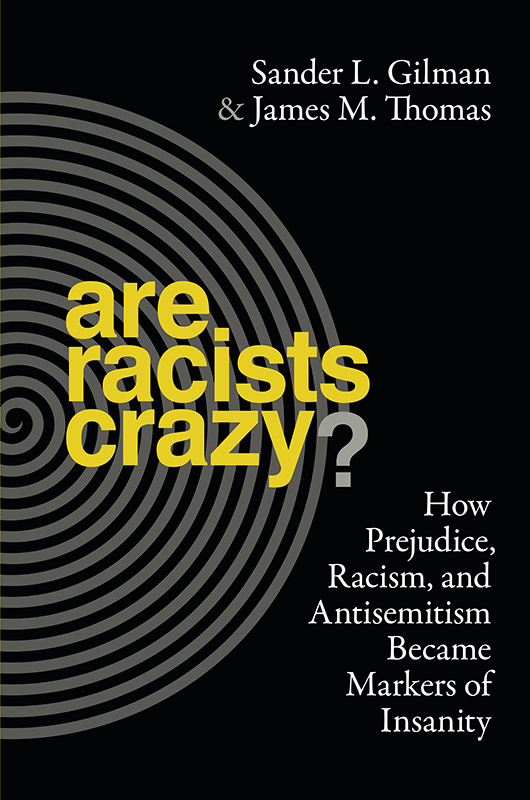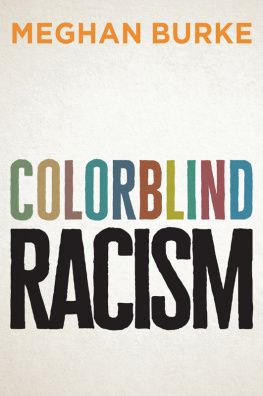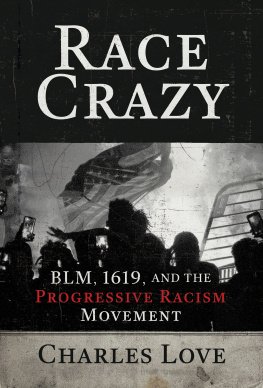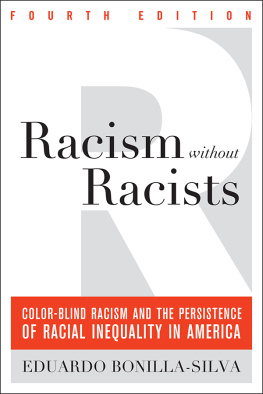
Are Racists Crazy?
Biopolitics: Medicine, Technoscience, and Health in the 21st Century
General Editors: Monica J. Casper and Lisa Jean Moore
Missing Bodies: The Politics of Visibility
Monica J. Casper and Lisa Jean Moore
Against Health: How Health Became the New Morality
Edited by Jonathan M. Metzl and Anna Kirkland
Is Breast Best? Taking on the Breastfeeding Experts and the New High Stakes of Motherhood
Joan B. Wolf
Biopolitics: An Advanced Introduction
Thomas Lemke
The Material Gene: Gender, Race, and Heredity after the Human Genome Project
Kelly E. Happe
Cloning Wild Life: Zoos, Captivity, and the Future of Endangered Animals
Carrie Friese
Eating Drugs: Psychopharmaceutical Pluralism in India
Stefan Ecks
Phantom Limb: Amputation, Embodiment, and Prosthetic Technology
Cassandra S. Crawford
Heart-Sick: The Politics of Risk, Inequality, and Heart Disease
Janet K. Shim
Plucked: A History of Hair Removal
Rebecca M. Herzig
Contesting Intersex: The Dubious Diagnosis
Georgiann Davis
Men at Risk: Masculinity, Heterosexuality, and HIV Prevention
Shari L. Dworkin
To Fix or To Heal: Patient Care, Public Health, and the Limits of Biomedicine
Edited by Joseph E. Davis and Ana Marta Gonzlez
Mattering: Feminism, Science, and Materialism
Edited by Victoria Pitts-Taylor
Are Racists Crazy? How Prejudice, Racism, and Antisemitism Became Markers of Insanity
Sander L. Gilman and James M. Thomas
Are Racists Crazy?
How Prejudice, Racism, and Antisemitism Became Markers of Insanity
Sander L. Gilman and James M. Thomas

NEW YORK UNIVERSITY PRESS
New York
NEW YORK UNIVERSITY PRESS
New York
www.nyupress.org
2016 by New York University
All rights reserved
References to Internet websites (URLs) were accurate at the time of writing. Neither the author nor New York University Press is responsible for URLs that may have expired or changed since the manuscript was prepared.
Library of Congress Cataloging-in-Publication Data
Names: Gilman, Sander L., author. | Thomas, James M., 1982 author.
Title: Are racists crazy? : how prejudice, racism, and antisemitism became markers of insanity / Sander L. Gilman and James M. Thomas.
Description: New York : New York University Press, [2016] | Series: Biopolitics: medicine, technoscience, and health in the 21st century | Includes bibliographical references and index.
Identifiers: LCCN 2016023905 | ISBN 978-1-4798-5612-1 (cl : alk. paper)
Subjects: LCSH: PrejudicesPsychological aspects. | RacismPsychological aspects. | AntisemitismPsychological aspects. | Mental illness.
Classification: LCC BF575.P9 G55 2016 | DDC 303.3/85dc23
LC record available at https://lccn.loc.gov/2016023905
New York University Press books are printed on acid-free paper, and their binding materials are chosen for strength and durability. We strive to use environmentally responsible suppliers and materials to the greatest extent possible in publishing our books.
Manufactured in the United States of America
10 9 8 7 6 5 4 3 2 1
Also available as an ebook
Contents
This book arose out of a car trip. Sander Gilman was invited to come to the University of Mississippi to speak on race and madness as part of the University of Mississippi Critical Race Studies Groups Fall Symposium on the intertwining legacies of Jews and black Americans. One of the Critical Race Studies Groups members, James JT Thomas, was designated to pick him up at Memphis and drive him the hour to Oxford. On the way, as they chatted about a number of things, the topic of the afternoon talk arose and both were pleased to note that despite very different disciplinary directions, Gilman as a cultural historian and Thomas as a sociologist, they shared a deep interest in the difficulty and complexity of thinking about race and psychopathology as a cultural problem, indeed as a litmus test for our complicated understanding of race, racism, and mental illness. A joint project description arose after the visit. Ilene Kalish of New York University Press and the editors of its series Biopolitics: Medicine, Technoscience, and Health in the Twenty-First Century, Monica J. Casper and Lisa Jean Moore, encouraged the writing of the volume.
Given the authors different disciplinary backgrounds, the work on the manuscript was from the beginning clearly divided. However, each read and commented on the others work in a critical and productive way. The end result is an overview of a complex topic with which we hope to spur interest in the difficulties of writing and thinking across disciplines and, in this case, the broad historical span from the mid-nineteenth century to the present. Because this is an overview, much relevant material has been omitted, as the topic of each subchapter merits (and in some cases has received) its own monograph. But the question of the implications of considering group hatred as a psychopathology, spurred on by twenty-first-century claims ranging from a pill for prejudice to a test to identify the perpetrators of genocide in advance of their acts, seemed to us to warrant our strongly comparative approach.
We are grateful to the anonymous reviewers of both our proposal and the finished manuscript for a range of suggestions, most of which found their way into this book. We are also grateful to Kate Epstein for critically editing our text. We are also happy to acknowledge our students at the University of Mississippi and Emory University for their collaboration in the classes we have held on this and related topics. Living scholarship demands critical interaction and this we found in our classrooms. The readings for these classes and the discussion in them helped shape our argument. We are also grateful to Caelyn Cobb at New York University Press for shepherding the project. A special thanks is extended to the University of Mississippi Critical Race Studies Group, and in particular Willa Johnson, for helping to plant the seeds that would become this finished manuscript. Finally, a warm thanks to our families and loved ones, whose support and encouragement prove invaluable to our professional activities.
The Problem Limited
In February 2012, an interdisciplinary team of scientists at Oxford University performed a randomized, double-blind experiment whereby the researchers administered a beta-blocker commonly used to treat heart medication to one group of subjects, while giving the other a placebo.
In the aforementioned experiment, subjects in both groups were shown images of people of different races, alongside words with positive and negative meanings. They were then asked to rate how warm their feelings were toward different groups. Results showed that participants taking the beta-blocker scored significantly lower on the IAT, indicating they held lower levels of subconscious racial bias. Measures of explicit racial prejudice, however, were unaffected by the administering of the beta-blocker. One of the lead researchers, in a press release, stated, Such research raises the tantalising possibility that our unconscious racial attitudes could be modulated using drugs (emphasis ours).
The study quickly gained mass media attention, with its results, comments from the researchers, and editorials about the clinical trial published in outlets across the ideological spectrum, including the
Next page









